How to install a hood above a gas stove: step-by-step installation instructions
Independent installation of gas equipment in a private house or apartment is prohibited, but the hood does not apply to hoods. Volatile devices can be mounted on their own using the manufacturer's manual.
We will tell you how to install an extractor hood over a gas stove in accordance with the requirements of sanitary and hygienic and construction standards. We offer simple instructions that provide fastening strength and excellent functionality with maximum impact. In the article we presented, the most popular options are considered.
The content of the article:
The principle of operation of the electric hood
To begin with, let’s remember what the hood is for and how it works. The purpose of any model of exhaust equipment designed for installation above the stove is to clean the air of combustion products and odor, which is distributed throughout the apartment during cooking.
As you know, when burning natural gas forms many substances harmful to the health of the human body, including a large amount of nitrogen, carbon dioxide, carbon monoxide, and various impurities.
The faster the unwanted elements are brought out, the cleaner and safer the air will be. In a small room with a low percentage of oxygen in the air, a person begins to quickly get tired and feel unwell.
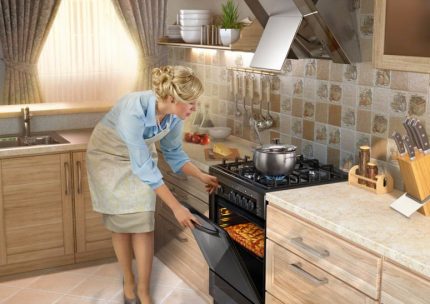
Air purification occurs in two ways. Some models simply remove it from the room, others pass through the cleaning filters. It should be understood that the hood cannot produce full ventilation of the kitchen.
In order for the air to become truly fresh and healthy, it is also necessary to establish fresh air ventilation.The easiest way to access the air is regular ventilation by opening windows and windows.
Comparative review of models
Modifications, which are presented in large quantities on the modern market, differ in the type of air purification, design and installation method. When choosing, you should not focus only on the design of the device. It is necessary to take into account all the nuances and consider the possibility of installing equipment in a particular case.
By and large, all modifications of hoods can be divided into three large categories:
- flowing;
- recirculation;
- combined.
The first type is designed to transport combustion products to the ventilation duct of the building through the duct. Therefore, in addition to attaching the hood housing over the gas stove, it will be necessary to install channels for air to enter the ventilation hole.
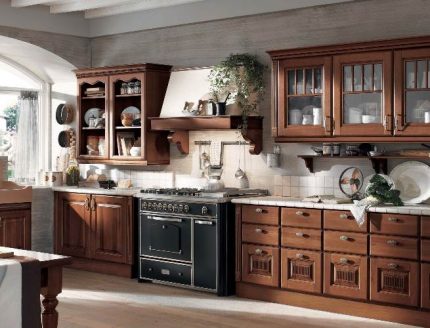
Recirculation models are not equipped with air ducts, so they take up less space and install much faster. They clean the air masses by passing them through grease and charcoal filters. In fact, they drive air in a circle, freeing it from vapors, grease and harmful particles, but not refreshing.
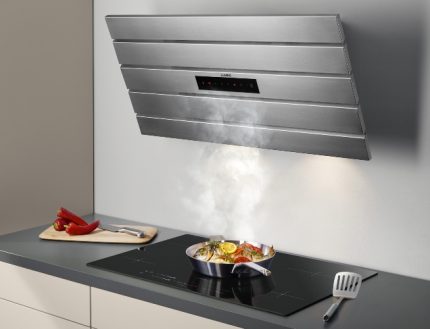
However, a huge segment of the market was occupied by universal models that can function in both modes: flow and recirculation. Cleaning through filters can be carried out temporarily while repairing the discharge lines.
And if it is not possible to install air ducts, then filtering is the only possible way to improve the microclimate in the kitchen.
According to the installation method, exhaust kitchen equipment is divided into stand-alone and built-in. The first is mounted separately, on a wall or ceiling, and the second is built into kitchen cabinets or other suspended structures.
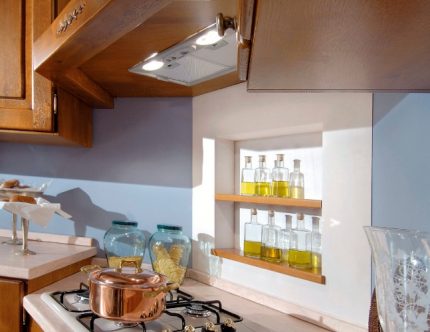
According to the design and, accordingly, the appearance of the hood, they are divided into several types, while they may have different names for different manufacturers. The most popular are the so-called built-in sliders, one part of which is movable, domed and tilted models.
Due to the popularity of the “island” kitchen interior, ceiling models for work areas installed in the center of the kitchen have become popular.
The hood is installed depending on the design and functions of the model. To understand the features of installation, you can even ask the consultant for installation instructions before buying.
Perhaps there are some nuances that prevent the installation of this particular product in your kitchen. Suppose the ceiling structure cannot support the weight of the equipment or openings are not provided in the cabinets for the passage of the duct.
Requirements for the installation of household appliances
A few words about the norms for installing equipment in rooms with gas stoves. According to the law, a gas-powered stove itself can be installed in rooms with a height of at least 2.2 m. It is worth knowing to those who are going to build voluminous suspension structures to mask air ducts or ventilation ducts.
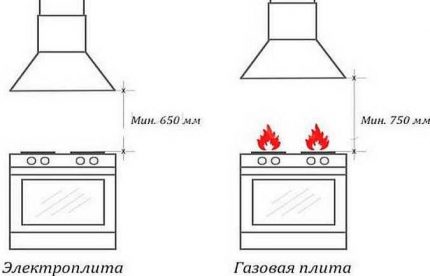
The documentation governing installation or selection is publicly available. General materials on the importance of forced ventilation can be found in SNiP 2.04.05-91, more about the volumes of air discharged can be found in SNiP 2.08.01-89, and about performance and other nuances of equipment, see GOST 26813-99.
Strict rules regarding installation options ventilation ducts, no, therefore they can be placed outside or inside kitchen cabinets, behind partitions and over suspended structures.
Where exactly is it better to fix the purchased hood and what conditions are needed for this, you will learn from Recommended Articleswhose material is fully devoted to this issue.
Features of the installation of kitchen hoods
The sequence and nuances of installation depend on the design features of the equipment. For example, mounting order recirculation model and autonomous dome type with air duct fundamentally different. Therefore, we will consider how the professional installation of three different modifications occurs.
How to install an inclined model?
The middle price segment is the most popular. The Quartz exhaust hood, which can be installed independently, belongs to him. It works in perimeter suction mode, therefore it is placed in a clearly fixed position and does not have moving elements.
After installation, you need to connect the device to power and test its operation by checking the operation in various modes and at all possible speeds.
Sometimes, due to improper installation of false pipes or ducts, a loud buzz appears. In this case, you need to find the cause of the noise and try to get rid of it.
Mounting procedure for the integrated module
Models built into wall cabinets are very popular due to their compact size and reasonable price. If you take care in advance of the correct design and dimensions of the special cabinet base, then the process of mounting the case itself will take no more than 20 minutes. When installing flow-through devices, it will take some more time to conduct the duct.
Do not forget that the main document is a guide to installation of built-in hoodcompiled by the manufacturer. Before starting work, open the instructions and check the list for the presence of parts and fasteners. If everything is in order, we check the integrity of the elements and proceed to installation.
If you plan to install plastic duct, before mounting the hood in the cabinet, the adapter must be fixed on its upper side. This is a plastic universal part, consisting of fragments of different diameters.
Using a jigsaw or hacksaw, you need to cut out a part that is suitable in size. If the diameter of the duct completely coincides with the outlet, then an adapter is not needed.
Installing an island hood
There is an individual instruction for each island type model. However, the general principles of mounting and connection can be understood by analyzing the following photo instruction.
It presents the installation of a rectangular rectangular ceiling hood, which consists of three main parts: a casing-duct, a motor compartment and a working panel.
After the work is done, we thoroughly wipe all the hood panels and check how it works.
If duct installation, fastening and connecting the hood made without errors, it will function in various modes, without making additional noise.
Conclusions and useful video on the topic
Video instructions from manufacturers and qualified installers will help to cope with the installation of exhaust equipment even to an ordinary inexperienced layman.
Video # 1. How to do the installation with your own hands of an inclined model:
Video # 2. Instructions and tips for installing the built-in hood:
Video # 3. General recommendations for selection and installation:
As you can see, the installation process presents several simple steps. However, they will be absolutely useless if you choose the wrong model, neglect the accuracy of the layout and do not worry about the design of the cabinet or the possibility of installing an air duct in advance.
But compliance with standards, competent calculations and accuracy will allow you to use the hood for a long time and with pleasure.
Want to talk about how to install a cooker hood with your own hands? Is there any useful information worth sharing with site visitors? Please write comments, post thematic photos and ask questions in the block below.

 How to hang a hood over a gas stove: step-by-step installation guide
How to hang a hood over a gas stove: step-by-step installation guide 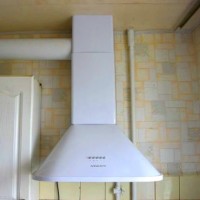 How to install the hood if the gas pipe interferes: briefing on the work
How to install the hood if the gas pipe interferes: briefing on the work 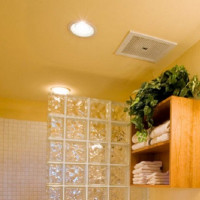 Ventilation in the bathroom in the ceiling: arrangement features + installation instructions for the fan
Ventilation in the bathroom in the ceiling: arrangement features + installation instructions for the fan  Ventilation pipes for the roof: tips for choosing a pipeline + installation instruction
Ventilation pipes for the roof: tips for choosing a pipeline + installation instruction 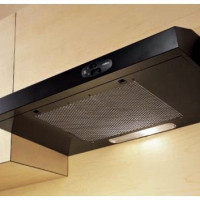 Installing the built-in hood: location options and installation instructions
Installing the built-in hood: location options and installation instructions  DIY hood installation in the kitchen: detailed step-by-step installation instructions
DIY hood installation in the kitchen: detailed step-by-step installation instructions  How much does it cost to connect gas to a private house: the price of organizing gas supply
How much does it cost to connect gas to a private house: the price of organizing gas supply  The best washing machines with dryer: model rating and customer tips
The best washing machines with dryer: model rating and customer tips  What is the color temperature of light and the nuances of choosing the temperature of the lamps to suit your needs
What is the color temperature of light and the nuances of choosing the temperature of the lamps to suit your needs  Replacement of a geyser in an apartment: replacement paperwork + basic norms and requirements
Replacement of a geyser in an apartment: replacement paperwork + basic norms and requirements
Before buying a hood, I consulted with a professional, I spent the whole day on measurements and calculations. After the purchase, I carefully studied the instructions and prepared mentally. Installation itself took about an hour, everything turned out just fine. He was pleased with himself, a little ingenuity and hands from the right place should grow. I think any sensible man will cope on his own.
I installed a hood in my friend’s apartment. I did it over a gas stove for the first time, before that I only set it above an electric stove at home.I want to say that there are no major differences, except perhaps the minimum height above the stove. The gas should be higher. Well, one must be more careful, of course, keep in mind that gas pipes are nearby. And so, all the same, the installation principles are the same.
The specialist was lost in time. It would be necessary to change the numbers of the guidelines. Something has already been canceled or replaced.